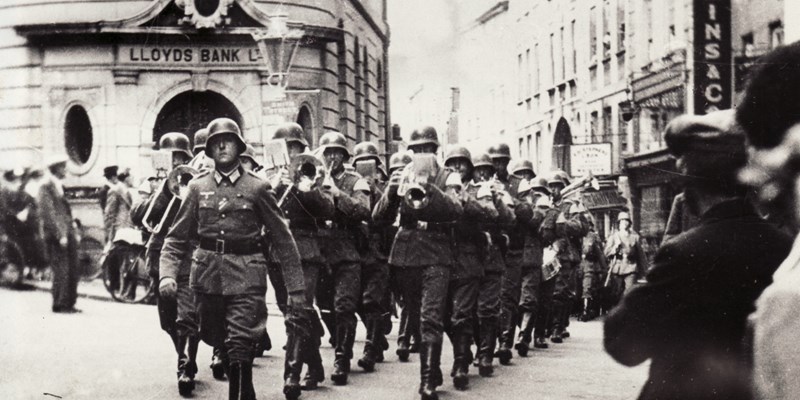We invited TV adventurer and historian, Dan Snow, to explore some of the fortifications still standing today on Guernsey, guided around the sites by local silver accredited tour guide, Amanda Johns for his History Hit platforms.
Dan described Guernsey as ‘a stunning, strategic outpost of the British Isles’, and, as he got to see more of the Island, he said that ‘it’s clear that an enormous amount of effort was spent on its defence’ during the war.
Watch the video below to see what Dan discovered.
On the 30th June 1940, German forces landed on The Islands of Guernsey and thus began five years of occupation. Guernsey was to be a fortress against Allied attack, and so the German army quickly got to work building hundreds of reinforced bunkers, gun emplacements and tunnels.
Batterie Mirus
The first stop on Dan’s exportation of Guernsey’s bunkers was the Batterie Mirus. Situated on Guernsey’s west coast, above L’Eree, the Batterie is spread over an area of 1km by 0.75km. Built by the Germans in World War 2, it housed four huge navel guns capable of firing 12inch shells with a range of 51km. Although these guns were removed in the early 1950s, the reinforced concrete structures and associated positions remain intact. There were thousands of German soldiers posted on Guernsey, and 72 of these were stationed at Batterie Mirus to help defend the Island.
Dan Snow and Amanda Johns were joined by Steve Powell from Festung Guernsey to explore the biggest site of its kind in the Channel Islands. Inside the bunker, Dan was fascinated by the sketchings and markings on the walls that are all unique to the site. There are four rooms where the crew slept, with three tiers of bunk beds for them to squeeze into. These rooms would have had wooden panelling on the walls, but this was removed after the war to be used as fuel, revealing the drawings and inscriptions made by soldiers underneath. Dan described the site as ‘an unbelievable concrete footprint’ from the occupation and thought that it was in ‘an amazing state of preservation’.
Image via Festung Facebook Page.
The Underground Hospital
For Dan’s next exploration, he and Amanda were joined by Festung Guernsey’s Pierre Renier. They visited the German Underground Hospital, the largest structural reminder of the German Occupation that exists in the Channel Islands. Almost invisible from the surface, save for the entrances, the hospital and ammunition store is a maze of tunnels originally designed to hold reserve troops, and spans over 75,000 square foot. Through fear of an allied retaliation for the occupation of the Channel Islands, this fortress was designed to safely hold troops and withstand an attack. It was designed by German engineers and construction was overseen by German soldiers, but the structure itself was made by forced workers. At full capacity, the hospital could hold 800 individuals. Whilst the hospital never saw full capacity, after D Day there was a lot of allied air activity around the Island, with some German ships being attacked, and some of the German naval personnel who were injured offshore were taken to the Underground Hospital instead of the German medical hospitals that were on the outskirts of St Peter Port.
The Islands of Guernsey were liberated on 9th May 1945, following the general German surrender, after five years of occupation. A major attack never took place on Guernsey, meaning that, although a lot of the materials and items left behind by the Germans were used to rebuild the Island, a lot of the structures built during the war remain in good condition. Dan even commented that ‘the traces of the Second World War that remain on Guernsey are remarkable’.
*The above video was part of a paid partnership on History Hit channels.












